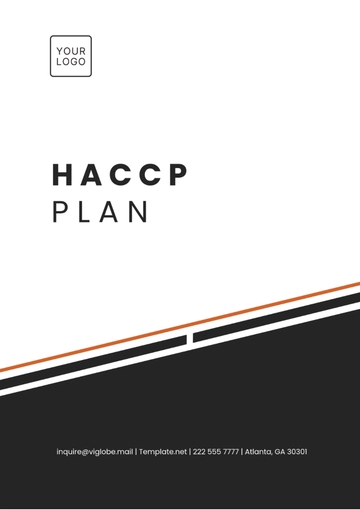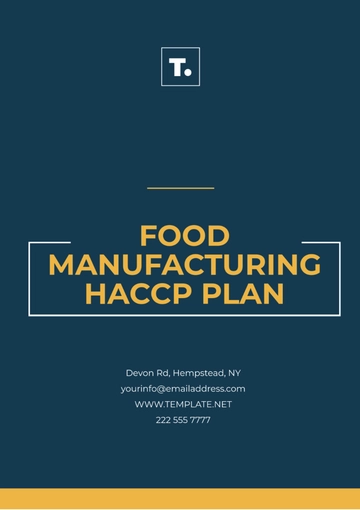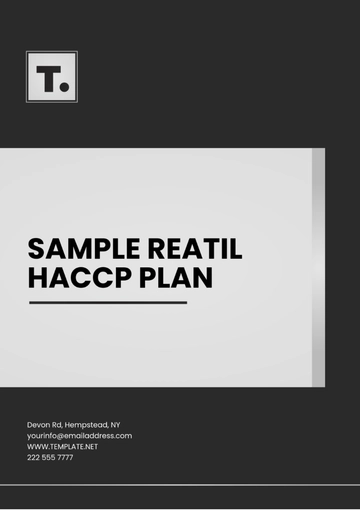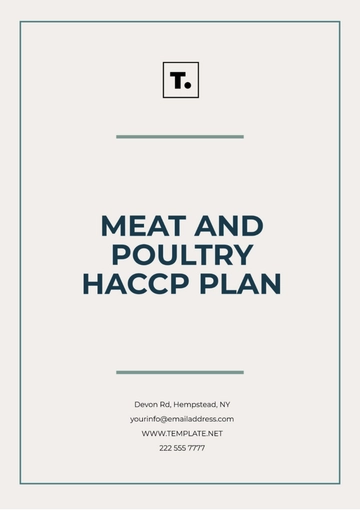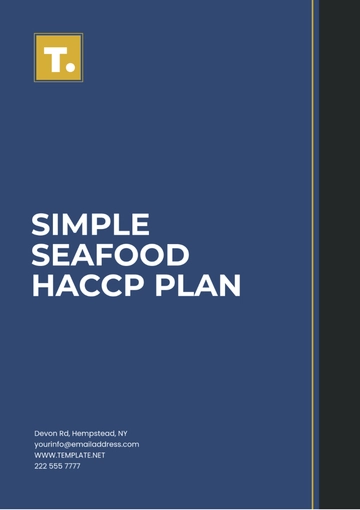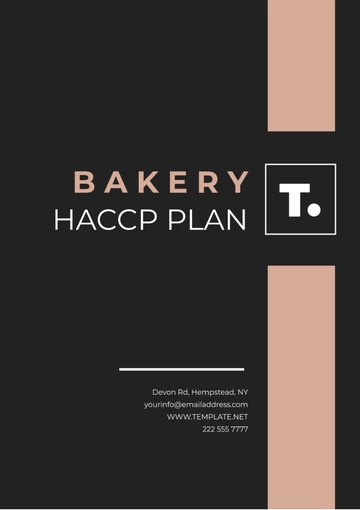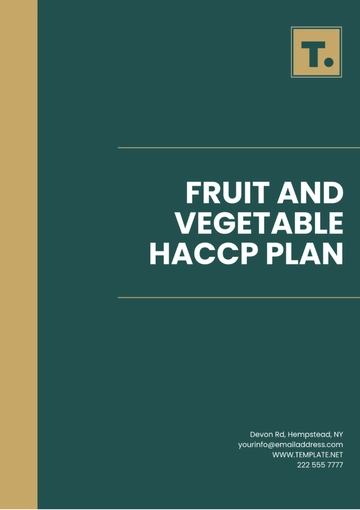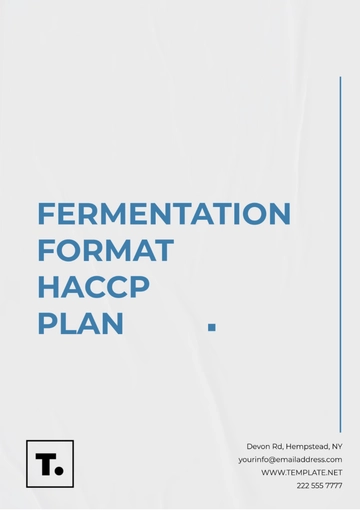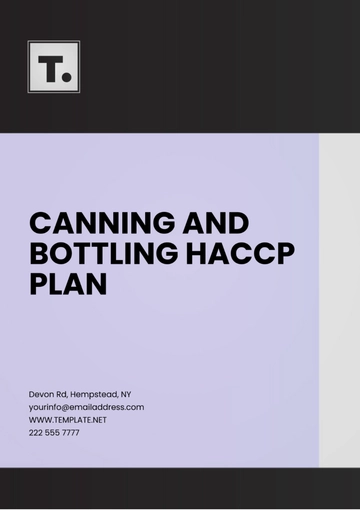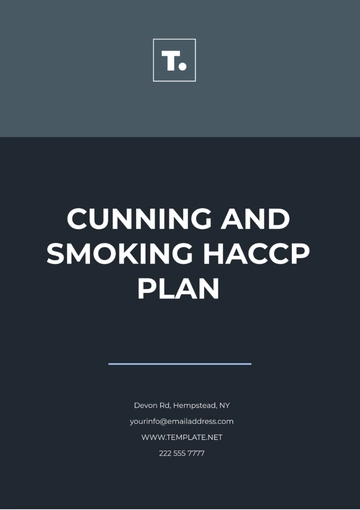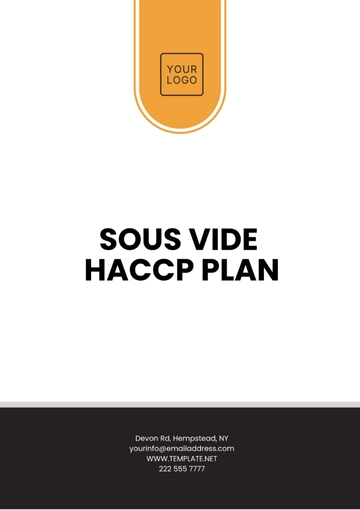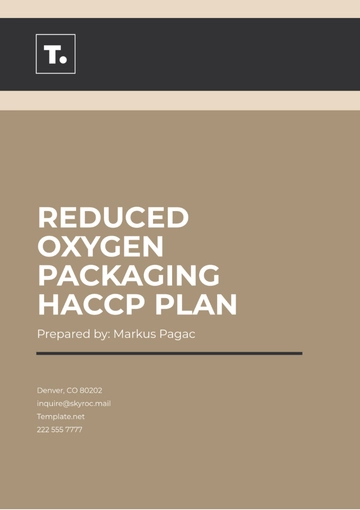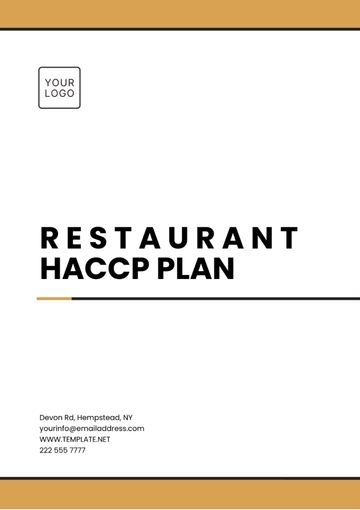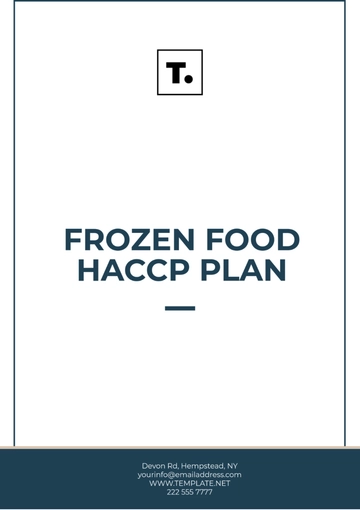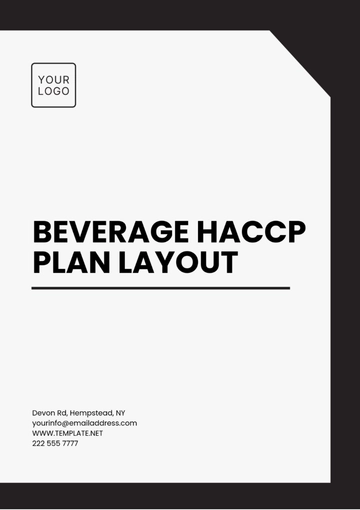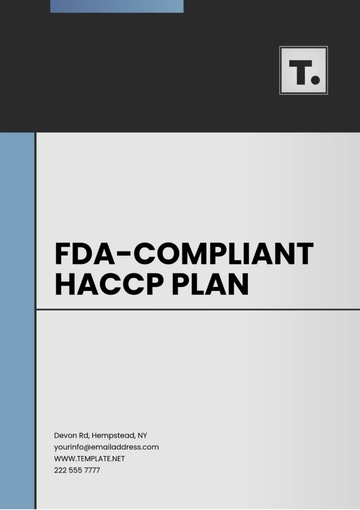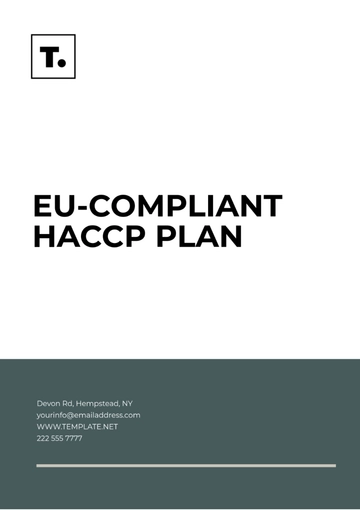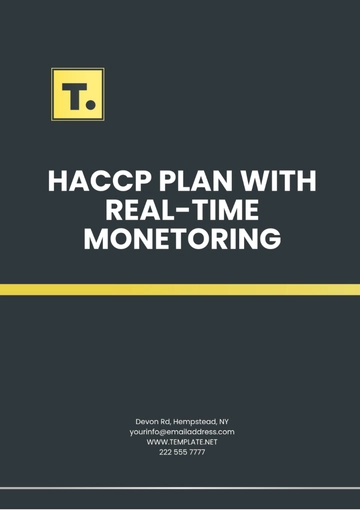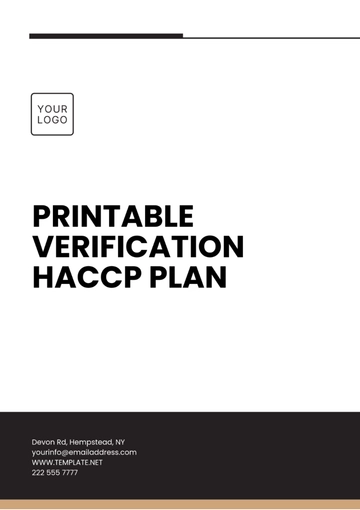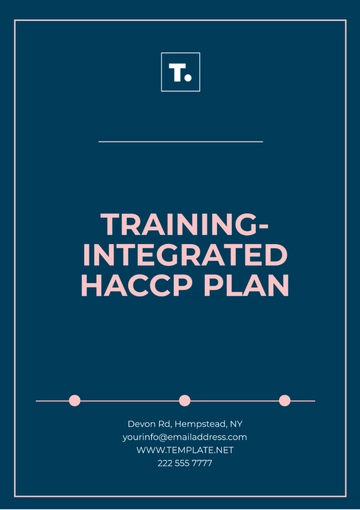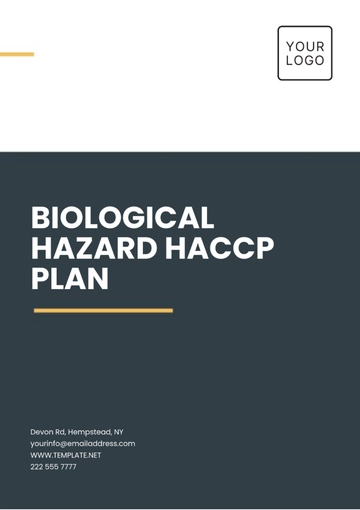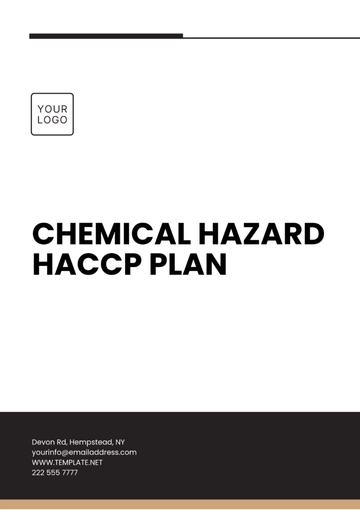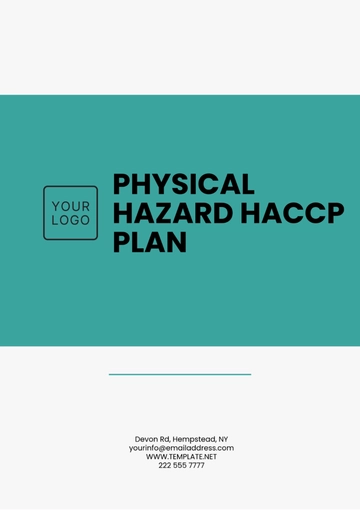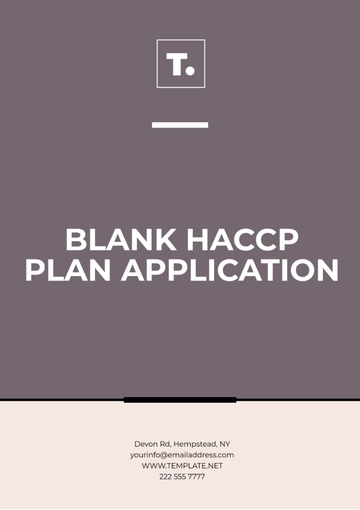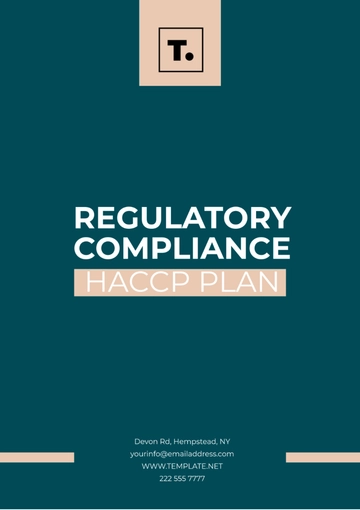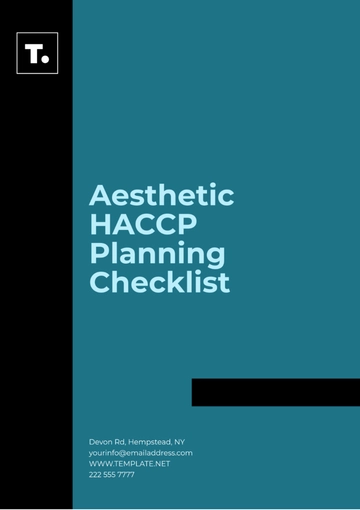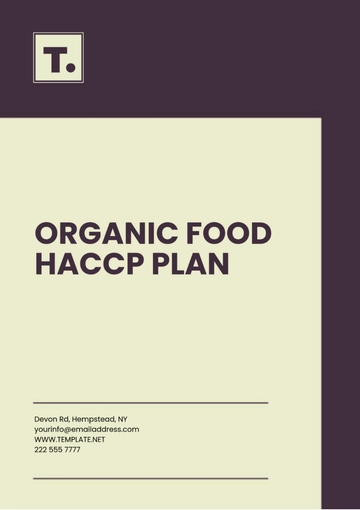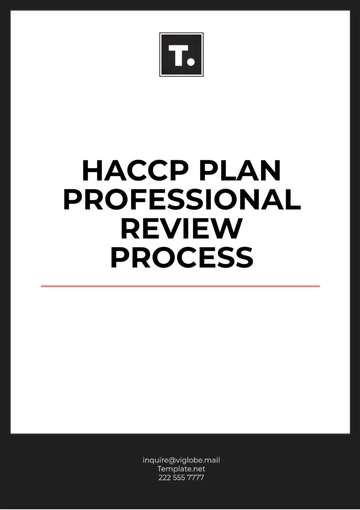Free Reduced Oxygen Packaging HACCP Plan
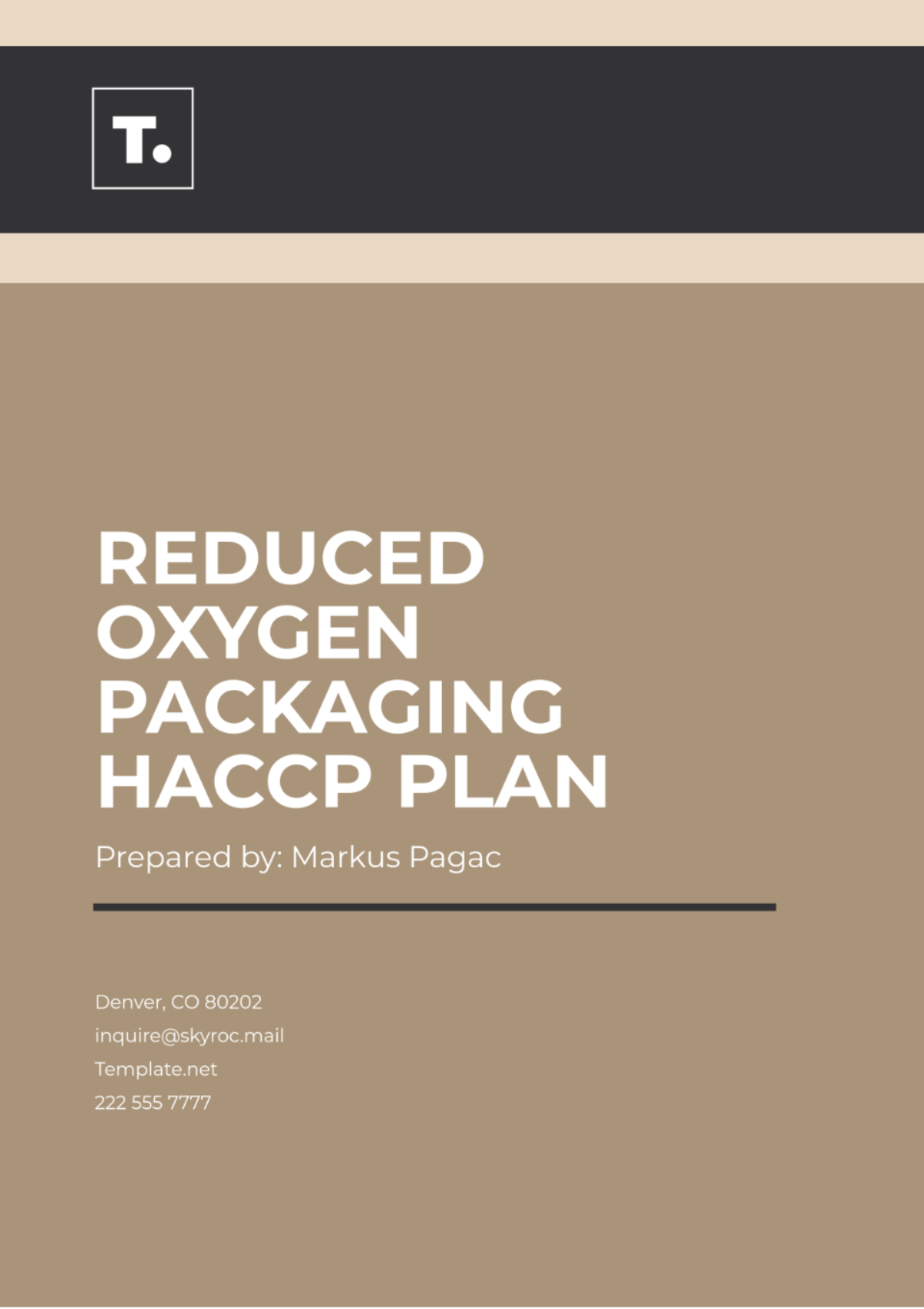
Date: October 19, 2060
Prepared By: [YOUR NAME]
I. Introduction
The Reduced Oxygen Packaging HACCP Plan is a structured strategy aimed at identifying, assessing, and managing food safety risks linked to packaging techniques that decrease oxygen levels around food, like vacuum sealing and modified atmosphere packaging, which can foster pathogen growth, and outlines essential procedures to minimize these risks, ensuring safe consumption of packaged foods, reflecting our organization's dedication to food safety, regulatory adherence, and consumer wellbeing.
II. HACCP Team
The HACCP Team is comprised of individuals with diverse expertise, ensuring a comprehensive approach to food safety. Team members are assigned specific roles and responsibilities to effectively implement and monitor the HACCP plan. The team includes:
HACCP Coordinator: Mia Miler, HACCP Manager, Responsible for overall HACCP plan development, implementation, and compliance.
Quality Assurance Manager: Logan Clark, QA Manager, Oversees quality control measures, conducts audits, and ensures documentation integrity.
Production Supervisor: Aria Lee, Production Supervisor, Manages day-to-day operations on the packaging line and oversees staff training.
Microbiologist: Ava Lawrence, Microbiologist, Provides expertise on microbial hazards and assists with testing and validation.
Maintenance Technician: Robert Green, Maintenance Tech, Ensures that all equipment is functioning properly and maintained according to safety standards.
III. Product Description
This section details the food products subjected to reduced oxygen packaging, outlining essential characteristics to identify potential hazards accurately. Each product description includes:
Attribute | Details |
|---|---|
Product Name | Gourmet Herb Chicken |
Ingredients | Chicken breast, olive oil, garlic, rosemary, thyme, salt, black pepper (contains allergens: none) |
Packaging Method | Vacuum sealing with ROP multilayer pouches |
Storage Conditions | Maintain refrigeration at 32°F to 40°F (0°C to 4°C) with a shelf life of 14 days from packaging date |
Intended Use | For retail sales in grocery stores; cook before consumption |
IV. Process Flow Diagram
The process flow diagram visually represents each step involved in the reduced oxygen packaging process, facilitating easy identification of critical control points and potential hazards. The diagram should encompass the following stages:
Raw Material Receiving: Inspection and documentation of incoming ingredients.
Pre-processing: Preparation activities, including washing, trimming, and marinating.
Packaging: Packaging food with ROP while ensuring protocol adherence.
Labeling: Accurate product labeling with expiration dates and storage instructions.
Storage: Conditions maintained to ensure product safety before distribution.
Distribution: Transporting packaged products while ensuring they remain within safe temperature ranges.
V. Hazard Analysis
This section identifies and evaluates potential hazards associated with ROP, including biological, chemical, and physical risks. Each hazard is assessed based on its likelihood and severity, enabling the identification of necessary control measures:
Biological Hazards:
Pathogens: Clostridium botulinum, Listeria monocytogenes, and Escherichia coli. The potential for growth increases in low-oxygen environments.
Chemical Hazards:
Residues: Cleaning agents or sanitizers that may contaminate food if not properly rinsed.
Additives: Improper use of preservatives or flavoring agents that may lead to allergic reactions.
Physical Hazards:
Foreign Objects: Glass shards, metal fragments, or other contaminants from packaging materials.
VI. Critical Control Points (CCPs)
Based on the hazard analysis, the following Critical Control Points have been identified:
CCP | Step in Process | Control Measure | Critical Limit |
|---|---|---|---|
CCP 1 | Packaging | Ensure proper vacuum levels | Minimum vacuum pressure of 24 inHg, verified every 15 minutes |
CCP 2 | Storage | Maintain appropriate refrigeration | Temperature maintained below 40°F, recorded every 4 hours |
CCP 3 | Product Testing | Conduct microbiological testing | Negative results for specified pathogens tested every 100 batches |
VII. Monitoring Procedures
Robust monitoring procedures are essential for verifying control at each CCP. These procedures include:
CCP 1 (Packaging)
Monitoring Method: Use calibrated vacuum gauges to check vacuum levels every 15 minutes, ensuring proper packaging conditions for food safety.
Documentation: Record measurements on a log sheet, reviewed daily. Anomalies will prompt immediate investigations.
CCP 2 (Storage)
Monitoring Method: Implement temperature data loggers for continuous monitoring, with manual checks conducted twice daily to ensure safe storage conditions.
Documentation: Log temperature readings, including deviations. Investigate non-compliance and document corrective actions.
CCP 3 (Product Testing)
Monitoring Method: Conduct microbiological testing on samples from every 100 batches to detect potential contaminants.
Documentation: Keep detailed records of testing results and dates, ensuring traceability and regulatory compliance.
VIII. Corrective Actions
Corrective actions must be predefined and implemented swiftly to address deviations from critical limits. The following actions will be taken for each CCP:
CCP 1 (Vacuum Levels)
Action: If vacuum levels are inadequate, immediately repackage affected products and determine the cause of the failure. Review equipment for maintenance needs.
CCP 2 (Storage Temperature)
Action: If temperatures exceed limits, quarantine affected products, assess their safety, and determine whether they can be salvaged or must be disposed of.
CCP 3 (Microbiological Testing)
Action: In the event of positive results for pathogens, isolate the batch, initiate a root cause analysis, and enhance sanitation protocols.
IX. Verification Procedures
Verification procedures ensure that the HACCP plan is effective and consistently implemented. These include:
Record Review: Conduct a weekly review of monitoring records to ensure compliance with established limits.
Internal Audits: Schedule annual internal audits of the HACCP plan, focusing on the effectiveness of control measures and documentation practices.
Third-party Audits: Engage third-party auditors at least once a year to evaluate compliance and provide recommendations for improvement.
Equipment Calibration: Verify the calibration of monitoring equipment quarterly to maintain accuracy and reliability.
X. Record Keeping
Maintaining comprehensive records is essential for compliance and traceability. All records related to the HACCP plan will include:
Monitoring Logs: Documenting daily monitoring of CCPs, including temperature logs and vacuum measurements.
Corrective Action Records: Detailed logs of all corrective actions taken, including investigations and outcomes.
Verification Reports: Documentation of internal and external audits, including findings and follow-up actions.
Training Records: Maintaining records of staff training sessions related to food safety and HACCP compliance.
- 100% Customizable, free editor
- Access 1 Million+ Templates, photo’s & graphics
- Download or share as a template
- Click and replace photos, graphics, text, backgrounds
- Resize, crop, AI write & more
- Access advanced editor
Simplify your HACCP planning for reduced oxygen packaging with Template.net’s Reduced Oxygen Packaging HACCP Plan Template. Customizable and editable, this template provides a structured approach to identifying and controlling food safety hazards. Editable in our Ai Editor Tool, it allows you to tailor your plan to meet regulatory standards and operational requirements.
You may also like
- Finance Plan
- Construction Plan
- Sales Plan
- Development Plan
- Career Plan
- Budget Plan
- HR Plan
- Education Plan
- Transition Plan
- Work Plan
- Training Plan
- Communication Plan
- Operation Plan
- Health And Safety Plan
- Strategy Plan
- Professional Development Plan
- Advertising Plan
- Risk Management Plan
- Restaurant Plan
- School Plan
- Nursing Home Patient Care Plan
- Nursing Care Plan
- Plan Event
- Startup Plan
- Social Media Plan
- Staffing Plan
- Annual Plan
- Content Plan
- Payment Plan
- Implementation Plan
- Hotel Plan
- Workout Plan
- Accounting Plan
- Campaign Plan
- Essay Plan
- 30 60 90 Day Plan
- Research Plan
- Recruitment Plan
- 90 Day Plan
- Quarterly Plan
- Emergency Plan
- 5 Year Plan
- Gym Plan
- Personal Plan
- IT and Software Plan
- Treatment Plan
- Real Estate Plan
- Law Firm Plan
- Healthcare Plan
- Improvement Plan
- Media Plan
- 5 Year Business Plan
- Learning Plan
- Marketing Campaign Plan
- Travel Agency Plan
- Cleaning Services Plan
- Interior Design Plan
- Performance Plan
- PR Plan
- Birth Plan
- Life Plan
- SEO Plan
- Disaster Recovery Plan
- Continuity Plan
- Launch Plan
- Legal Plan
- Behavior Plan
- Performance Improvement Plan
- Salon Plan
- Security Plan
- Security Management Plan
- Employee Development Plan
- Quality Plan
- Service Improvement Plan
- Growth Plan
- Incident Response Plan
- Basketball Plan
- Emergency Action Plan
- Product Launch Plan
- Spa Plan
- Employee Training Plan
- Data Analysis Plan
- Employee Action Plan
- Territory Plan
- Audit Plan
- Classroom Plan
- Activity Plan
- Parenting Plan
- Care Plan
- Project Execution Plan
- Exercise Plan
- Internship Plan
- Software Development Plan
- Continuous Improvement Plan
- Leave Plan
- 90 Day Sales Plan
- Advertising Agency Plan
- Employee Transition Plan
- Smart Action Plan
- Workplace Safety Plan
- Behavior Change Plan
- Contingency Plan
- Continuity of Operations Plan
- Health Plan
- Quality Control Plan
- Self Plan
- Sports Development Plan
- Change Management Plan
- Ecommerce Plan
- Personal Financial Plan
- Process Improvement Plan
- 30-60-90 Day Sales Plan
- Crisis Management Plan
- Engagement Plan
- Execution Plan
- Pandemic Plan
- Quality Assurance Plan
- Service Continuity Plan
- Agile Project Plan
- Fundraising Plan
- Job Transition Plan
- Asset Maintenance Plan
- Maintenance Plan
- Software Test Plan
- Staff Training and Development Plan
- 3 Year Plan
- Brand Activation Plan
- Release Plan
- Resource Plan
- Risk Mitigation Plan
- Teacher Plan
- 30 60 90 Day Plan for New Manager
- Food Safety Plan
- Food Truck Plan
- Hiring Plan
- Quality Management Plan
- Wellness Plan
- Behavior Intervention Plan
- Bonus Plan
- Investment Plan
- Maternity Leave Plan
- Pandemic Response Plan
- Succession Planning
- Coaching Plan
- Configuration Management Plan
- Remote Work Plan
- Self Care Plan
- Teaching Plan
- 100-Day Plan
- HACCP Plan
- Student Plan
- Sustainability Plan
- 30 60 90 Day Plan for Interview
- Access Plan
- Site Specific Safety Plan
